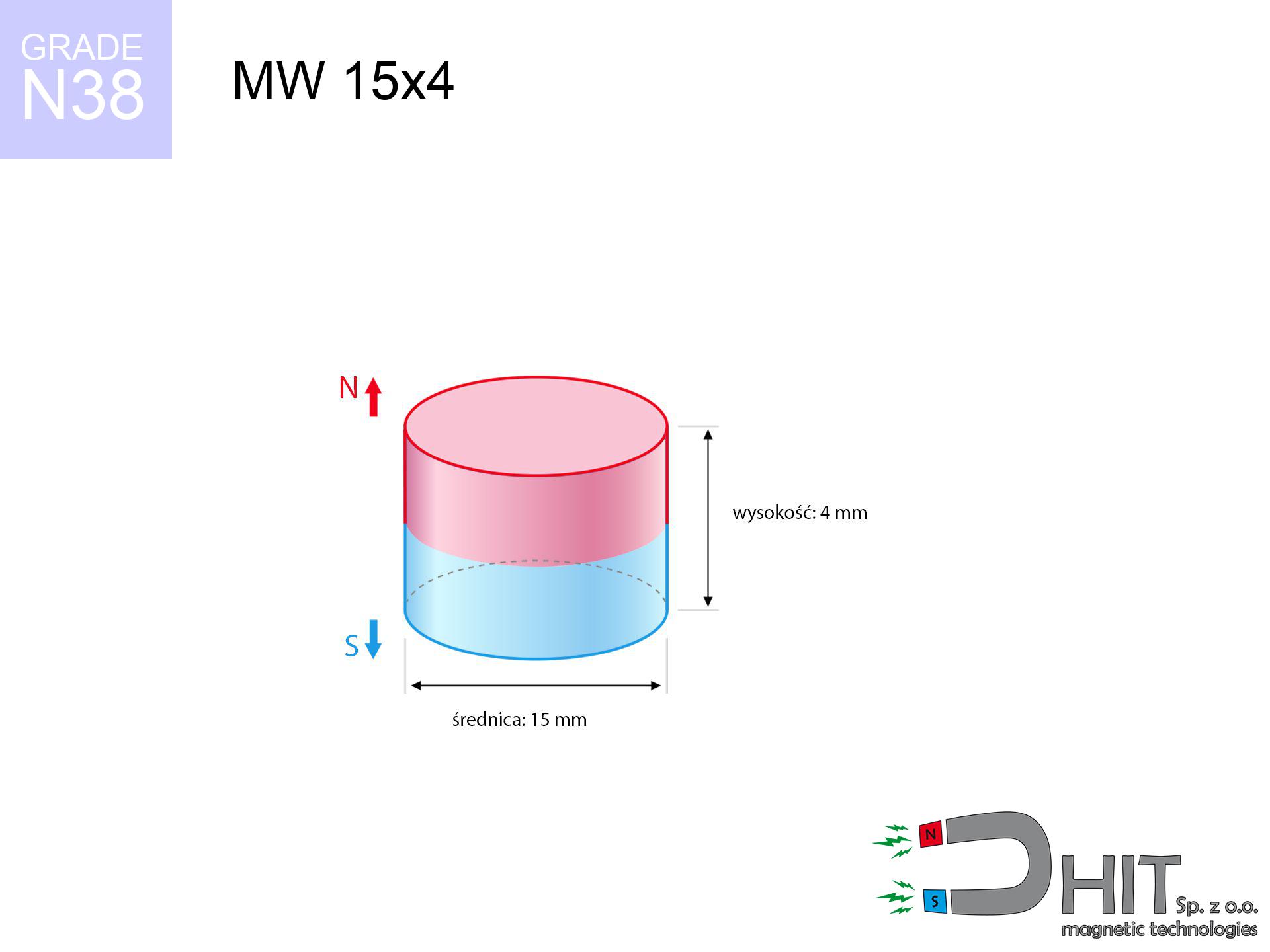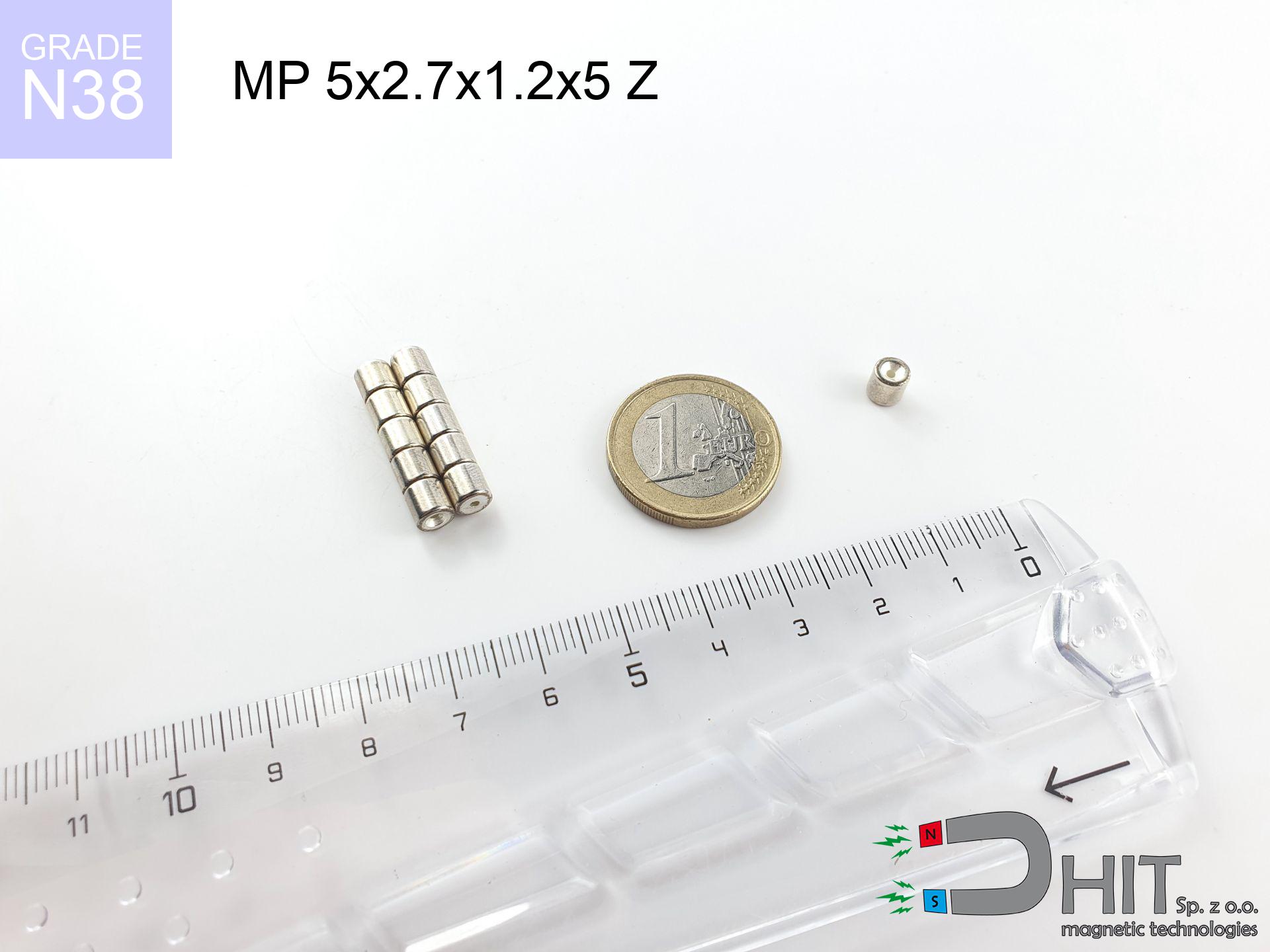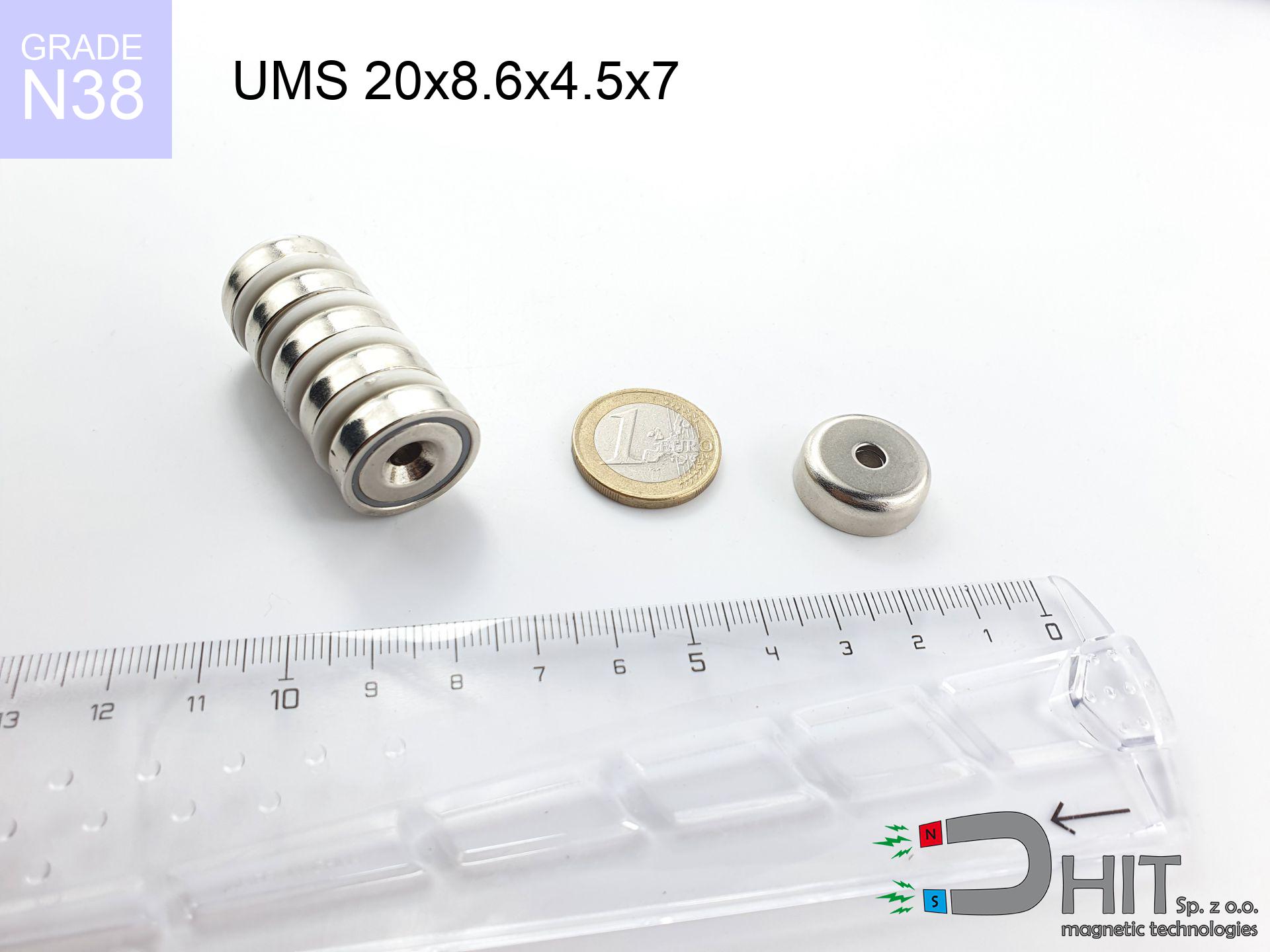MW 15x4 / N38 - cylindrical magnet
cylindrical magnet
Catalog no 010030
GTIN/EAN: 5906301810292
Diameter Ø
15 mm [±0,1 mm]
Height
4 mm [±0,1 mm]
Weight
5.3 g
Magnetization Direction
↑ axial
Load capacity
4.22 kg / 41.38 N
Magnetic Induction
291.60 mT / 2916 Gs
Coating
[NiCuNi] Nickel
1.968 ZŁ with VAT / pcs + price for transport
1.600 ZŁ net + 23% VAT / pcs
bulk discounts:
Need more?
Give us a call
+48 22 499 98 98
if you prefer drop us a message through
inquiry form
through our site.
Specifications and structure of magnets can be verified with our
modular calculator.
Same-day shipping for orders placed before 14:00.
Technical parameters - MW 15x4 / N38 - cylindrical magnet
Specification / characteristics - MW 15x4 / N38 - cylindrical magnet
| properties | values |
|---|---|
| Cat. no. | 010030 |
| GTIN/EAN | 5906301810292 |
| Production/Distribution | Dhit sp. z o.o. |
| Country of origin | Poland / China / Germany |
| Customs code | 85059029 |
| Diameter Ø | 15 mm [±0,1 mm] |
| Height | 4 mm [±0,1 mm] |
| Weight | 5.3 g |
| Magnetization Direction | ↑ axial |
| Load capacity ~ ? | 4.22 kg / 41.38 N |
| Magnetic Induction ~ ? | 291.60 mT / 2916 Gs |
| Coating | [NiCuNi] Nickel |
| Manufacturing Tolerance | ±0.1 mm |
Magnetic properties of material N38
| properties | values | units |
|---|---|---|
| remenance Br [min. - max.] ? | 12.2-12.6 | kGs |
| remenance Br [min. - max.] ? | 1220-1260 | mT |
| coercivity bHc ? | 10.8-11.5 | kOe |
| coercivity bHc ? | 860-915 | kA/m |
| actual internal force iHc | ≥ 12 | kOe |
| actual internal force iHc | ≥ 955 | kA/m |
| energy density [min. - max.] ? | 36-38 | BH max MGOe |
| energy density [min. - max.] ? | 287-303 | BH max KJ/m |
| max. temperature ? | ≤ 80 | °C |
Physical properties of sintered neodymium magnets Nd2Fe14B at 20°C
| properties | values | units |
|---|---|---|
| Vickers hardness | ≥550 | Hv |
| Density | ≥7.4 | g/cm3 |
| Curie Temperature TC | 312 - 380 | °C |
| Curie Temperature TF | 593 - 716 | °F |
| Specific resistance | 150 | μΩ⋅cm |
| Bending strength | 250 | MPa |
| Compressive strength | 1000~1100 | MPa |
| Thermal expansion parallel (∥) to orientation (M) | (3-4) x 10-6 | °C-1 |
| Thermal expansion perpendicular (⊥) to orientation (M) | -(1-3) x 10-6 | °C-1 |
| Young's modulus | 1.7 x 104 | kg/mm² |
Technical analysis of the assembly - report
Presented information constitute the direct effect of a physical analysis. Values rely on models for the material Nd2Fe14B. Real-world performance may deviate from the simulation results. Treat these data as a reference point for designers.
Table 1: Static pull force (pull vs distance) - interaction chart
MW 15x4 / N38
| Distance (mm) | Induction (Gauss) / mT | Pull Force (kg) | Risk Status |
|---|---|---|---|
| 0 mm |
2915 Gs
291.5 mT
|
4.22 kg / 4220.0 g
41.4 N
|
strong |
| 1 mm |
2620 Gs
262.0 mT
|
3.41 kg / 3408.2 g
33.4 N
|
strong |
| 2 mm |
2276 Gs
227.6 mT
|
2.57 kg / 2571.6 g
25.2 N
|
strong |
| 3 mm |
1928 Gs
192.8 mT
|
1.85 kg / 1845.5 g
18.1 N
|
safe |
| 5 mm |
1324 Gs
132.4 mT
|
0.87 kg / 870.3 g
8.5 N
|
safe |
| 10 mm |
505 Gs
50.5 mT
|
0.13 kg / 126.7 g
1.2 N
|
safe |
| 15 mm |
222 Gs
22.2 mT
|
0.02 kg / 24.4 g
0.2 N
|
safe |
| 20 mm |
113 Gs
11.3 mT
|
0.01 kg / 6.3 g
0.1 N
|
safe |
| 30 mm |
40 Gs
4.0 mT
|
0.00 kg / 0.8 g
0.0 N
|
safe |
| 50 mm |
10 Gs
1.0 mT
|
0.00 kg / 0.0 g
0.0 N
|
safe |
Table 2: Vertical load (wall)
MW 15x4 / N38
| Distance (mm) | Friction coefficient | Pull Force (kg) |
|---|---|---|
| 0 mm | Stal (~0.2) |
0.84 kg / 844.0 g
8.3 N
|
| 1 mm | Stal (~0.2) |
0.68 kg / 682.0 g
6.7 N
|
| 2 mm | Stal (~0.2) |
0.51 kg / 514.0 g
5.0 N
|
| 3 mm | Stal (~0.2) |
0.37 kg / 370.0 g
3.6 N
|
| 5 mm | Stal (~0.2) |
0.17 kg / 174.0 g
1.7 N
|
| 10 mm | Stal (~0.2) |
0.03 kg / 26.0 g
0.3 N
|
| 15 mm | Stal (~0.2) |
0.00 kg / 4.0 g
0.0 N
|
| 20 mm | Stal (~0.2) |
0.00 kg / 2.0 g
0.0 N
|
| 30 mm | Stal (~0.2) |
0.00 kg / 0.0 g
0.0 N
|
| 50 mm | Stal (~0.2) |
0.00 kg / 0.0 g
0.0 N
|
Table 3: Wall mounting (shearing) - vertical pull
MW 15x4 / N38
| Surface type | Friction coefficient / % Mocy | Max load (kg) |
|---|---|---|
| Raw steel |
µ = 0.3
30% Nominalnej Siły
|
1.27 kg / 1266.0 g
12.4 N
|
| Painted steel (standard) |
µ = 0.2
20% Nominalnej Siły
|
0.84 kg / 844.0 g
8.3 N
|
| Oily/slippery steel |
µ = 0.1
10% Nominalnej Siły
|
0.42 kg / 422.0 g
4.1 N
|
| Magnet with anti-slip rubber |
µ = 0.5
50% Nominalnej Siły
|
2.11 kg / 2110.0 g
20.7 N
|
Table 4: Material efficiency (saturation) - sheet metal selection
MW 15x4 / N38
| Steel thickness (mm) | % power | Real pull force (kg) |
|---|---|---|
| 0.5 mm |
|
0.42 kg / 422.0 g
4.1 N
|
| 1 mm |
|
1.06 kg / 1055.0 g
10.3 N
|
| 2 mm |
|
2.11 kg / 2110.0 g
20.7 N
|
| 5 mm |
|
4.22 kg / 4220.0 g
41.4 N
|
| 10 mm |
|
4.22 kg / 4220.0 g
41.4 N
|
Table 5: Thermal stability (material behavior) - power drop
MW 15x4 / N38
| Ambient temp. (°C) | Power loss | Remaining pull | Status |
|---|---|---|---|
| 20 °C | 0.0% |
4.22 kg / 4220.0 g
41.4 N
|
OK |
| 40 °C | -2.2% |
4.13 kg / 4127.2 g
40.5 N
|
OK |
| 60 °C | -4.4% |
4.03 kg / 4034.3 g
39.6 N
|
|
| 80 °C | -6.6% |
3.94 kg / 3941.5 g
38.7 N
|
|
| 100 °C | -28.8% |
3.00 kg / 3004.6 g
29.5 N
|
Table 6: Two magnets (repulsion) - field range
MW 15x4 / N38
| Gap (mm) | Attraction (kg) (N-S) | Repulsion (kg) (N-N) |
|---|---|---|
| 0 mm |
9.26 kg / 9258 g
90.8 N
4 518 Gs
|
N/A |
| 1 mm |
8.40 kg / 8404 g
82.4 N
5 555 Gs
|
7.56 kg / 7564 g
74.2 N
~0 Gs
|
| 2 mm |
7.48 kg / 7477 g
73.3 N
5 239 Gs
|
6.73 kg / 6729 g
66.0 N
~0 Gs
|
| 3 mm |
6.54 kg / 6542 g
64.2 N
4 901 Gs
|
5.89 kg / 5888 g
57.8 N
~0 Gs
|
| 5 mm |
4.80 kg / 4804 g
47.1 N
4 200 Gs
|
4.32 kg / 4324 g
42.4 N
~0 Gs
|
| 10 mm |
1.91 kg / 1909 g
18.7 N
2 648 Gs
|
1.72 kg / 1718 g
16.9 N
~0 Gs
|
| 20 mm |
0.28 kg / 278 g
2.7 N
1 010 Gs
|
0.25 kg / 250 g
2.5 N
~0 Gs
|
| 50 mm |
0.00 kg / 4 g
0.0 N
128 Gs
|
0.00 kg / 0 g
0.0 N
~0 Gs
|
Table 7: Safety (HSE) (implants) - precautionary measures
MW 15x4 / N38
| Object / Device | Limit (Gauss) / mT | Safe distance |
|---|---|---|
| Pacemaker | 5 Gs (0.5 mT) | 6.5 cm |
| Hearing aid | 10 Gs (1.0 mT) | 5.0 cm |
| Mechanical watch | 20 Gs (2.0 mT) | 4.0 cm |
| Phone / Smartphone | 40 Gs (4.0 mT) | 3.0 cm |
| Remote | 50 Gs (5.0 mT) | 3.0 cm |
| Payment card | 400 Gs (40.0 mT) | 1.5 cm |
| HDD hard drive | 600 Gs (60.0 mT) | 1.0 cm |
Table 8: Dynamics (kinetic energy) - collision effects
MW 15x4 / N38
| Start from (mm) | Speed (km/h) | Energy (J) | Predicted outcome |
|---|---|---|---|
| 10 mm |
28.99 km/h
(8.05 m/s)
|
0.17 J | |
| 30 mm |
49.30 km/h
(13.69 m/s)
|
0.50 J | |
| 50 mm |
63.63 km/h
(17.68 m/s)
|
0.83 J | |
| 100 mm |
89.99 km/h
(25.00 m/s)
|
1.66 J |
Table 9: Surface protection spec
MW 15x4 / N38
| Technical parameter | Value / Description |
|---|---|
| Coating type | [NiCuNi] Nickel |
| Layer structure | Nickel - Copper - Nickel |
| Layer thickness | 10-20 µm |
| Salt spray test (SST) ? | 24 h |
| Recommended environment | Indoors only (dry) |
Table 10: Electrical data (Pc)
MW 15x4 / N38
| Parameter | Value | SI Unit / Description |
|---|---|---|
| Magnetic Flux | 5 659 Mx | 56.6 µWb |
| Pc Coefficient | 0.37 | Low (Flat) |
Table 11: Underwater work (magnet fishing)
MW 15x4 / N38
| Environment | Effective steel pull | Effect |
|---|---|---|
| Air (land) | 4.22 kg | Standard |
| Water (riverbed) |
4.83 kg
(+0.61 kg Buoyancy gain)
|
+14.5% |
1. Shear force
*Warning: On a vertical wall, the magnet holds just a fraction of its perpendicular strength.
2. Steel saturation
*Thin metal sheet (e.g. 0.5mm PC case) drastically limits the holding force.
3. Temperature resistance
*For N38 grade, the safety limit is 80°C.
4. Demagnetization curve and operating point (B-H)
chart generated for the permeance coefficient Pc (Permeance Coefficient) = 0.37
This simulation demonstrates the magnetic stability of the selected magnet under specific geometric conditions. The solid red line represents the demagnetization curve (material potential), while the dashed blue line is the load line based on the magnet's geometry. The Pc (Permeance Coefficient), also known as the load line slope, is a dimensionless value that describes the relationship between the magnet's shape and its magnetic stability. The intersection of these two lines (the black dot) is the operating point — it determines the actual magnetic flux density generated by the magnet in this specific configuration. A higher Pc value means the magnet is more 'slender' (tall relative to its area), resulting in a higher operating point and better resistance to irreversible demagnetization caused by external fields or temperature. A value of 0.42 is relatively low (typical for flat magnets), meaning the operating point is closer to the 'knee' of the curve — caution is advised when operating at temperatures near the maximum limit to avoid strength loss.
Chemical composition
| iron (Fe) | 64% – 68% |
| neodymium (Nd) | 29% – 32% |
| boron (B) | 1.1% – 1.2% |
| dysprosium (Dy) | 0.5% – 2.0% |
| coating (Ni-Cu-Ni) | < 0.05% |
Ecology and recycling (GPSR)
| recyclability (EoL) | 100% |
| recycled raw materials | ~10% (pre-cons) |
| carbon footprint | low / zredukowany |
| waste code (EWC) | 16 02 16 |
View more products
Advantages as well as disadvantages of neodymium magnets.
Advantages
- They retain magnetic properties for almost 10 years – the loss is just ~1% (in theory),
- They retain their magnetic properties even under external field action,
- A magnet with a shiny gold surface has better aesthetics,
- Magnetic induction on the working part of the magnet turns out to be exceptional,
- Made from properly selected components, these magnets show impressive resistance to high heat, enabling them to function (depending on their shape) at temperatures up to 230°C and above...
- Considering the possibility of free shaping and adaptation to custom needs, magnetic components can be manufactured in a variety of shapes and sizes, which expands the range of possible applications,
- Wide application in electronics industry – they are used in hard drives, brushless drives, medical equipment, as well as multitasking production systems.
- Thanks to concentrated force, small magnets offer high operating force, occupying minimum space,
Cons
- Susceptibility to cracking is one of their disadvantages. Upon strong impact they can fracture. We advise keeping them in a strong case, which not only secures them against impacts but also increases their durability
- We warn that neodymium magnets can reduce their strength at high temperatures. To prevent this, we suggest our specialized [AH] magnets, which work effectively even at 230°C.
- Due to the susceptibility of magnets to corrosion in a humid environment, we advise using waterproof magnets made of rubber, plastic or other material immune to moisture, when using outdoors
- Due to limitations in creating nuts and complex shapes in magnets, we recommend using a housing - magnetic holder.
- Potential hazard to health – tiny shards of magnets can be dangerous, if swallowed, which becomes key in the aspect of protecting the youngest. It is also worth noting that tiny parts of these magnets are able to be problematic in diagnostics medical after entering the body.
- High unit price – neodymium magnets cost more than other types of magnets (e.g. ferrite), which hinders application in large quantities
Pull force analysis
Best holding force of the magnet in ideal parameters – what it depends on?
- with the application of a sheet made of special test steel, ensuring full magnetic saturation
- with a cross-section minimum 10 mm
- characterized by lack of roughness
- under conditions of ideal adhesion (surface-to-surface)
- for force applied at a right angle (in the magnet axis)
- at standard ambient temperature
Key elements affecting lifting force
- Air gap (betwixt the magnet and the metal), since even a tiny distance (e.g. 0.5 mm) results in a reduction in force by up to 50% (this also applies to varnish, corrosion or debris).
- Force direction – declared lifting capacity refers to detachment vertically. When attempting to slide, the magnet holds much less (often approx. 20-30% of maximum force).
- Substrate thickness – for full efficiency, the steel must be adequately massive. Thin sheet restricts the lifting capacity (the magnet "punches through" it).
- Metal type – different alloys attracts identically. Alloy additives weaken the interaction with the magnet.
- Surface quality – the more even the plate, the larger the contact zone and higher the lifting capacity. Roughness acts like micro-gaps.
- Heat – NdFeB sinters have a sensitivity to temperature. At higher temperatures they lose power, and at low temperatures gain strength (up to a certain limit).
Lifting capacity was assessed by applying a smooth steel plate of suitable thickness (min. 20 mm), under perpendicular pulling force, whereas under attempts to slide the magnet the holding force is lower. In addition, even a slight gap between the magnet’s surface and the plate decreases the load capacity.
H&S for magnets
Threat to electronics
Avoid bringing magnets near a purse, laptop, or TV. The magnetism can irreversibly ruin these devices and wipe information from cards.
Bone fractures
Pinching hazard: The pulling power is so great that it can result in blood blisters, pinching, and broken bones. Protective gloves are recommended.
Allergy Warning
It is widely known that the nickel plating (standard magnet coating) is a strong allergen. If you have an allergy, avoid direct skin contact and select encased magnets.
Impact on smartphones
GPS units and smartphones are extremely susceptible to magnetism. Close proximity with a strong magnet can permanently damage the sensors in your phone.
Risk of cracking
Watch out for shards. Magnets can explode upon violent connection, ejecting shards into the air. We recommend safety glasses.
Dust explosion hazard
Combustion risk: Neodymium dust is explosive. Do not process magnets in home conditions as this risks ignition.
Demagnetization risk
Do not overheat. Neodymium magnets are sensitive to heat. If you need resistance above 80°C, inquire about special high-temperature series (H, SH, UH).
Safe operation
Handle with care. Neodymium magnets act from a distance and snap with huge force, often faster than you can move away.
Choking Hazard
Absolutely store magnets away from children. Ingestion danger is significant, and the effects of magnets connecting inside the body are fatal.
Warning for heart patients
Patients with a ICD must maintain an safe separation from magnets. The magnetic field can interfere with the operation of the life-saving device.





![UMGGZ 34x6 [M4] GZ / N38 - rubber magnetic holder external thread UMGGZ 34x6 [M4] GZ / N38 - rubber magnetic holder external thread](https://cdn3.dhit.pl/graphics/products/umg-34x6-m4-gz-rad.jpg)



